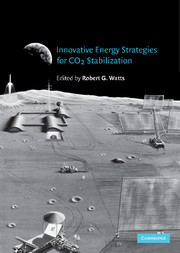Book contents
- Frontmatter
- Contents
- List of contributors
- 1 Concerns about Climate Change and Global Warming
- 2 Posing the Problem
- 3 Adaptive Strategies for Climate Change
- 4 Energy Efficiency: a Little Goes a Long Way
- 5 The Potential of Renewable Energy to Reduce Carbon Emissions
- 6 Carbonless Transportation and Energy Storage in Future Energy Systems
- 7 What Can Nuclear Power Accomplish to Reduce CO2 Emissions
- 8 Nuclear Fusion Energy
- 9 Energy Prosperity Within the Twenty-first Century and Beyond: Options and the Unique Roles of the Sun and the Moon
- 10 Geoengineering the Climate: History and Prospect
- Index
10 - Geoengineering the Climate: History and Prospect
Published online by Cambridge University Press: 22 October 2009
- Frontmatter
- Contents
- List of contributors
- 1 Concerns about Climate Change and Global Warming
- 2 Posing the Problem
- 3 Adaptive Strategies for Climate Change
- 4 Energy Efficiency: a Little Goes a Long Way
- 5 The Potential of Renewable Energy to Reduce Carbon Emissions
- 6 Carbonless Transportation and Energy Storage in Future Energy Systems
- 7 What Can Nuclear Power Accomplish to Reduce CO2 Emissions
- 8 Nuclear Fusion Energy
- 9 Energy Prosperity Within the Twenty-first Century and Beyond: Options and the Unique Roles of the Sun and the Moon
- 10 Geoengineering the Climate: History and Prospect
- Index
Summary
Introduction
The possibility of using geoengineering – the deliberate manipulation of the planetary environment – to counteract anthropogenic climate change is deeply controversial. At least in name, geoengineering has largely been ignored in recent climate assessments (Bruce, Lee et al., 1996; Watson, Zinyowera et al., 1996). Under close examination, however, the distinction between geoengineering and other responses to the CO2-climate problem proves to be fuzzy. Use of the term geoengineering is shifting, as advocates of response strategies that were formerly labeled geoengineering now seek to avoid the term. Section 10.2 elaborates a definition of geoengineering; assessment of the implications of its shifting meaning are deferred to the concluding discussion.
Historical perspective is vital to understanding the role of geoengineering in human choices about climate. The historical background sketched in Section 10.3 shows that proposals to engineer the climate are deeply woven into the history of the CO2-climate problem. The focus is on the postwar rise of weather and climate modification and the interweaving of its decline with rising concern about inadvertent climate modification. The evolving status of geoengineering as a response to anthropogenic climate change is examined through a review of US climate assessments and the IPCC assessment reports.
Section 10.4 reviews proposals to geoengineer the climate.
- Type
- Chapter
- Information
- Innovative Energy Strategies for CO2 Stabilization , pp. 411 - 453Publisher: Cambridge University PressPrint publication year: 2002
- 1
- Cited by



